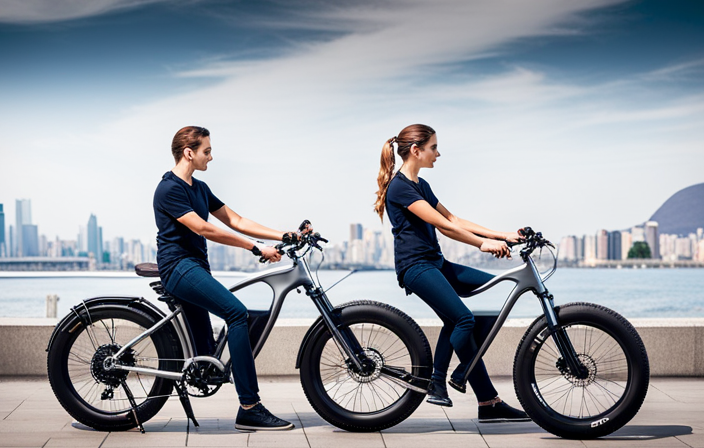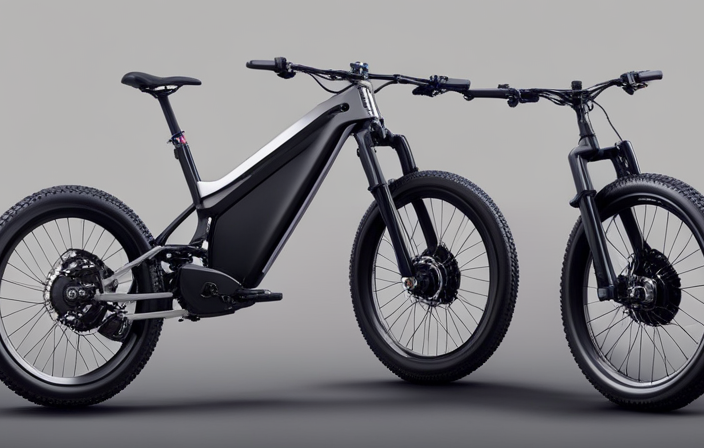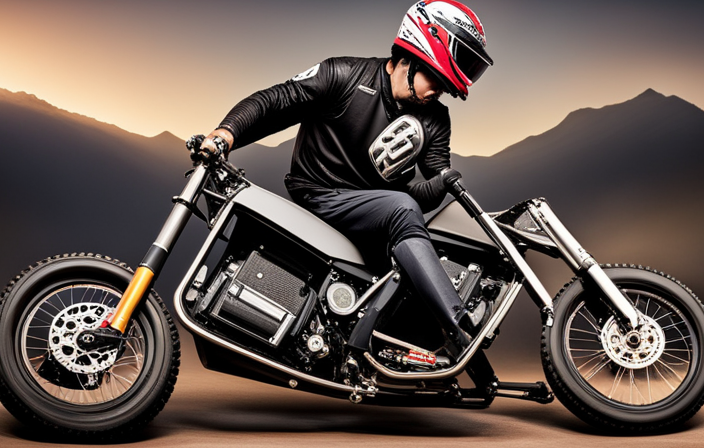Have you ever wondered how an electric assist bike works? Well, wonder no more!
In this article, we will delve into the technical details of these innovative bikes and explore the inner workings of their electric motor and battery.
We will also discuss the different modes of power and control, as well as the process of charging your e-bike.
So, if you’re ready to uncover the secrets behind this modern transportation marvel, let’s dive in!
Key Takeaways
- Electric assist bikes have an electric motor that provides assistance to the rider.
- The motor is powered by a battery and motor power is measured in watts.
- Pedal assist senses the rider’s pedaling motion and provides additional power accordingly.
- Throttle control adjusts the speed and power output of the electric motor.
The Basics of Electric Assist Bikes
If you’re new to electric assist bikes, you’ll want to understand the basics of how they work.
Electric assist bikes, also known as e-bikes, are bicycles equipped with an electric motor that provides assistance to the rider. The motor is powered by a battery, which can be charged using a standard electrical outlet.
Understanding motor power is crucial when choosing an e-bike. The power of the motor is measured in watts and determines how much assistance the motor can provide. Higher wattage motors offer more power and can assist the rider on steeper inclines or at higher speeds.
The benefits of electric assist are numerous. They make cycling easier and more accessible for people of all fitness levels and ages. They also allow riders to travel longer distances with less effort.
Understanding the electric motor is the next step in fully comprehending how electric assist bikes work.
Understanding the Electric Motor
Understanding the electric motor is essential in comprehending how an e-bike operates. The electric motor is the heart of the electric assist system, converting electrical energy from the battery into mechanical power to propel the bike forward.
Electric motors used in e-bikes are typically brushless DC motors, known for their high efficiency and reliability. The motor’s efficiency is crucial in determining the overall performance of the e-bike, as it directly affects the range and power output. The efficiency of an electric motor is measured by the ratio of its mechanical power output to the electrical power input. Higher efficiency motors result in longer battery life and better overall performance.
The motor power output, measured in watts, determines how much power the motor can deliver to assist the rider. Transitioning into the subsequent section about the role of the battery, let’s now discuss how the electric motor and the battery work together to provide an electrifying biking experience.
The Role of the Battery
The battery plays a crucial role in powering the electric motor of an e-bike. It is responsible for storing and supplying the electrical energy needed to propel the bike.
The battery capacity determines how far the e-bike can travel on a single charge. Higher capacity batteries can provide a longer range, but they are also larger and heavier.
When the battery is depleted, it needs to be recharged using a charging infrastructure. Charging an e-bike battery typically takes a few hours, depending on the battery capacity and the charging method used.
Once the battery is fully charged, it can provide power to the electric motor, allowing the rider to experience the benefits of electric assist. This transition from the battery to the electric motor is seamless and occurs as the rider starts pedaling.
How Pedal Assist Works
Pedal assist works by sensing the rider’s pedaling motion and providing additional power accordingly. This is made possible through pedal sensor technology, which detects the rotation of the pedals. Once the sensor detects movement, it sends a signal to the motor controller, which then determines the amount of power to be delivered. The motor power output can vary depending on the level of assistance selected by the rider.
Here are four key features of pedal assist:
-
Seamless integration: The pedal assist system seamlessly integrates with the rider’s pedaling motion, providing a natural and intuitive riding experience.
-
Adjustable assistance levels: Riders can choose from multiple assistance levels, allowing them to customize the amount of power they receive.
-
Efficient energy utilization: The pedal assist system optimizes the use of battery power, ensuring maximum efficiency and range.
-
Automatic power delivery: The system automatically adjusts the power output based on the rider’s pedaling speed and force.
With an understanding of how pedal assist works, let’s explore the next topic: throttle control and power modes.
Throttle Control and Power Modes
To control the power and select different modes, you simply need to adjust the throttle on your electric bike. The throttle is a lever or button located on the handlebars that allows you to control the speed and power output of the electric motor. By adjusting the throttle, you can increase or decrease the amount of power being delivered to the motor, which in turn determines how fast you will go. Some electric bikes also have different power modes that you can select, such as eco, normal, and sport, which adjust the throttle sensitivity and energy consumption optimization. These modes allow you to customize your riding experience to suit your preferences and needs. Now let’s move on to the next section, where we will discuss the regenerative braking system.
Regenerative Braking System
When you’re riding an electric bike, you can engage the regenerative braking system to help recharge the battery. This system works by converting the kinetic energy generated during braking into electrical energy, which is then used to charge the battery. The regenerative braking efficiency varies depending on factors such as speed, terrain, and rider weight.
The benefits of regenerative braking are two-fold. Firstly, it helps to extend the range of the electric bike by capturing energy that would otherwise be lost as heat. This means that you can ride for longer distances without worrying about running out of battery power. Secondly, regenerative braking also reduces the wear and tear on the physical brakes, ultimately prolonging their lifespan.
By utilizing the regenerative braking system, electric bikes offer a more efficient and sustainable way of commuting. Now, let’s explore the various components and features that make electric bikes so unique.
Electric Bike Components and Features
Get ready to discover the components and features that make electric bikes so unique! Electric bikes consist of several key components that work together to provide a smooth and efficient ride. The most important component is the electric motor, which is responsible for providing the necessary power to assist the rider. This motor is typically located in the hub of the rear wheel or in the center of the bike frame. Another crucial component is the battery, which stores the energy needed to power the motor. Electric bike batteries are usually lithium-ion and can be easily removed for charging. Additionally, electric bikes are equipped with a controller that regulates the flow of power from the battery to the motor. This controller allows the rider to adjust the level of assistance provided by the motor. Other features commonly found on electric bikes include a display panel that shows vital information such as speed and battery level, as well as lights for increased visibility and safety. Maintaining an electric bike involves regular battery charging, checking tire pressure, and ensuring all components are functioning properly. The benefits of electric bikes are numerous, including increased range and speed, reduced effort while riding, and a more eco-friendly mode of transportation. By understanding the components and features of electric bikes, you can make an informed decision when choosing the right e-bike for your needs.
Choosing the Right E-Bike for Your Needs
Now that you have a good understanding of electric bike components and features, it’s time to delve into choosing the right e-bike for your needs.
When it comes to selecting an electric assist bike, there are various options to consider. Firstly, you need to determine the type of bike that suits your preferences and riding style. Whether it’s a mountain bike, road bike, or a hybrid, each type offers distinct features and advantages.
Additionally, you should consider the power options available for the e-bike. This includes different motor sizes and battery capacities, which will directly impact the bike’s performance and range.
To make your decision-making process easier, here are a few factors to consider:
- Riding terrain and distance
- Desired speed and acceleration
- Weight capacity and load requirements
- Budget constraints
Now that you know how to choose the right e-bike, let’s move on to the next section on maintaining and servicing your e-bike.
Maintaining and Servicing Your E-Bike
To ensure optimal performance and longevity, it’s important to regularly maintain and service your e-bike. E-bike maintenance involves a few key steps.
First, check the tire pressure and make sure it is within the recommended range.
Inspect the brakes and ensure they are functioning properly.
Lubricate the chain and gears to minimize friction and improve efficiency.
Additionally, regularly clean the bike to remove dirt and debris that can cause damage over time.
If you encounter any issues with your e-bike, troubleshooting is essential. Common problems include battery malfunctions, motor issues, and electrical glitches.
Refer to the manufacturer’s manual for specific troubleshooting steps or consult a professional for assistance.
By taking these maintenance measures and addressing issues promptly, you can keep your e-bike in top shape.
Moving on to safety considerations and riding tips…
Safety Considerations and Riding Tips
Before riding, it’s important to consider safety measures and keep in mind some riding tips. Here are four key points to ensure your safety and maximize your riding experience:
-
Wear a properly fitted helmet: Protect your head by wearing a helmet that fits snugly and meets safety standards. It should cover your forehead and sit level on your head.
-
Check your bike’s maintenance: Regularly inspect your electric assist bike for any loose bolts, worn-out tires, or faulty brakes. Keeping your bike in good condition ensures a safe and smooth ride.
-
Be aware of traffic and road conditions: Stay vigilant while riding, paying attention to traffic signals, pedestrians, and other road users. Adjust your speed and be cautious in adverse weather conditions.
-
Follow the rules of the road: Obey traffic laws, including signaling turns, stopping at red lights, and yielding to pedestrians. Be predictable and visible to other road users.
By following these safety considerations and riding tips, you can enjoy your electric assist bike while minimizing the risks.
Now, let’s explore the fascinating topic of range and battery life.
Range and Battery Life
Make sure you understand the range and battery life of your electric assist bicycle. This knowledge will help you plan your rides and prevent unexpected battery drain. The range of an electric bike depends on various factors, including the battery technology used and the terrain you are riding on. Lithium-ion batteries are commonly used in electric bikes due to their high energy density and long lifespan. To maximize your range, consider factors such as your weight, the assist level you choose, and the terrain. Riding on flat surfaces and using a lower assist level can help conserve battery power. Additionally, maintaining your battery properly, such as keeping it charged between 20-80%, can extend its overall lifespan. Understanding these factors will ensure you get the most out of your electric assist bike. Moving forward, let’s dive into the next section about charging your electric bike.
Charging Your Electric Bike
When charging your e-bike, you’ll want to ensure that you have a reliable power source. There are different charging methods you can use to keep your electric bike’s battery in optimal condition. Here are some tips for charging your e-bike:
- Use the charger provided by the manufacturer to avoid any compatibility issues.
- Plug the charger into a standard electrical outlet with a stable power supply.
- Avoid charging your e-bike in extreme temperatures, as it can affect the battery’s performance.
- Charge your bike regularly, even if the battery is not fully depleted, to maintain its overall health.
- Consider investing in a smart charger that can monitor and optimize the charging process.
By following these guidelines, you can ensure that your e-bike’s battery stays in good condition and lasts for a long time.
Now, let’s move on to comparing e-bike models and brands.
Comparing E-Bike Models and Brands
To compare e-bike models and brands, you’ll want to consider factors like price, range, and features.
When it comes to e-bike maintenance, it is essential to look for a brand that offers reliable and easily accessible service centers. You should also consider the availability of spare parts and the overall durability of the bike.
In terms of e-bike performance, pay attention to the motor power and torque, as these factors directly impact the bike’s acceleration and climbing ability. Additionally, battery capacity and charging time are crucial for longer rides. Some e-bikes also come with advanced features like pedal assist modes, LCD displays, and suspension systems for a smoother and more comfortable ride.
Taking all these factors into account will help you choose an e-bike that suits your needs and preferences.
Moving on to e-bike laws and regulations, it’s important to be aware of the rules in your area to ensure a safe and legal ride.
E-Bike Laws and Regulations
Be aware of the laws and regulations regarding e-bikes in your area to ensure a safe and legal ride. When it comes to e-bikes, different regions have different speed limits and classification systems in place. Understanding these rules is crucial for both your safety and compliance with the law.
E-bike speed limits vary depending on the classification of the bike. In some areas, Class 1 e-bikes, which provide pedal-assist up to a maximum speed of 20 mph, are allowed on bike lanes and paths. Class 2 e-bikes, which have a throttle and can reach speeds of up to 20 mph without pedaling, may have restrictions on where they can be ridden. Class 3 e-bikes, capable of speeds up to 28 mph, are often not allowed on bike paths and may require registration or licensing.
To better understand these regulations, refer to the following table:
| E-Bike Classification | Maximum Speed (mph) | Allowed on Bike Paths? | Registration/Licensing Required? |
|---|---|---|---|
| Class 1 | 20 | Yes | No |
| Class 2 | 20 | Varies | Varies |
| Class 3 | 28 | No | Varies |
Knowing the e-bike laws in your area will help you ride safely and avoid any potential legal issues. As technology continues to advance, future innovations in electric assist bikes are expected to further improve performance, efficiency, and user experience.
Future Innovations in Electric Assist Bikes
Now that you understand the laws and regulations surrounding electric assist bikes, let’s dive into the exciting world of future innovations in this field.
The future of electric bikes is bright, with advancements in smart technology and the use of sustainable materials. Here are some key developments to look forward to:
-
Integration of GPS technology: Electric bikes will have built-in GPS systems that can track your location, provide navigation assistance, and even help you find charging stations.
-
Lightweight and durable materials: Manufacturers are experimenting with sustainable materials like carbon fiber and bamboo, making electric bikes lighter, stronger, and more eco-friendly.
-
Energy regeneration systems: Future electric bikes may feature innovative energy regeneration systems that can harness and store energy from braking or pedaling, further extending the bike’s range.
-
Intelligent safety features: Electric bikes will incorporate advanced safety features such as collision detection, blind-spot monitoring, and adaptive cruise control to enhance rider safety.
These advancements promise to revolutionize the electric bike industry, making them more efficient, eco-friendly, and enjoyable to ride.
Frequently Asked Questions
Are electric assist bikes legal to use on public roads and bike paths?
Yes, electric assist bikes are legal to use on public roads and bike paths, as long as they adhere to certain regulations.
These regulations may vary depending on the specific region or country, but generally, electric assist bikes are subject to speed and power limits.
The benefits of using electric assist bikes include increased speed and reduced effort, making it easier to navigate hills and travel longer distances.
Additionally, they are eco-friendly and contribute to reducing carbon emissions.
How long does it take to charge an electric bike battery?
Charging time for an electric bike battery depends on its capacity. Typically, it takes around 3 to 4 hours to fully charge a 400-500Wh battery using a standard charger. However, charging times may vary based on the charger’s power output and the battery’s state of charge.
It is important to note that fast chargers can significantly reduce charging time. To ensure optimal battery life, it is recommended to avoid overcharging and to follow the manufacturer’s guidelines.
Can I ride an electric assist bike in the rain?
Yes, you can ride an electric assist bike in the rain. However, there are some riding techniques you should keep in mind.
Firstly, be cautious of slippery surfaces and reduced visibility. Use wider tires with good traction for better control. Additionally, avoid sudden braking and accelerate gradually to prevent skidding.
Advantages of riding in the rain include cooler temperatures and fewer people on the road. Disadvantages include the risk of rust and potential damage to electrical components.
How often do I need to service and maintain my electric bike?
To ensure optimal performance, you should service and maintain your electric bike regularly. The servicing frequency depends on your usage, but generally, it is recommended to have a comprehensive check-up every 6-12 months.
This includes inspecting the drivetrain, brakes, tires, and electrical components. Regular maintenance, such as cleaning and lubricating the chain, adjusting brakes, and tightening bolts, will help keep your bike running smoothly.
The maintenance cost can vary depending on the specific requirements of your bike and any potential repairs needed.
How much does an electric assist bike typically weigh?
On average, an electric assist bike typically weighs around 40-60 pounds. However, it’s important to note that the weight of an electric bike can vary depending on several factors.
The main factors affecting electric bike weight include the type and capacity of the battery, the frame material, the size of the motor, and the additional components such as lights, racks, and suspension.
These factors collectively contribute to the overall weight of an electric assist bike.
Conclusion
In conclusion, electric assist bikes are revolutionizing the way we commute and explore. These bikes provide a seamless and effortless riding experience with their powerful electric motors and efficient batteries. They offer a sustainable and convenient alternative to traditional bicycles, whether you’re conquering steep hills or cruising through city streets.
For example, imagine a commuter who used to struggle with a long and hilly journey to work. With an electric assist bike, they can now effortlessly navigate the terrain and arrive at their destination feeling refreshed and energized.
The future of electric assist bikes is promising, with ongoing innovations that will continue to enhance their performance and functionality. So why not hop on an electric assist bike and embrace the future of cycling?








